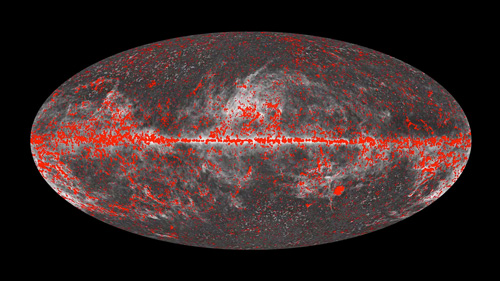| Basic Information | |
| What is this? | A map of the compact sources Planck has seen over the sky |
| Where is it in the sky? | All over, though many are located in the plane of our Galaxy |
| How big is it? | Some of the objects are relatively small clouds of dust, while others are massive galaxies in the distant Universe |
| How far away is it? | While some are will within our Galaxy, others are far beyond. |
| What do the colours represent? | Every red dot is an individual object, with the size of the dot corresponding to the brightness of the object as seen by Planck |
Downloads
As it scans the sky, Planck does not only see the Cosmic Micrwave Background. It also sees anything between Earth and the early Universe which is emitting microwave light. Some of that foreground light takes the form of diffuse emission – gas and dust in our own Galaxy. But Planck also encounters “compact sources” – essentially points of light when seen by Planck. There are over 15,000 of these, and in January 2011 a catalogue of them was released: the “Early Release Compact Course Catalogue”.
The catalogue has a number of unique features: it has the widest frequency coverage of any catalogue produced by a single telescope scanning the whole sky and it contains the first all-sky inventory of sources at submillimetre wavelengths. Optimised to detect the coldest galactic and extragalactic objects, it is also the first catalogue to cover the complete zoo of extragalactic sources, all the way from radio and infrared-luminous galaxies to clusters of galaxies.
The objects can be split into different categories. Firstly, there’s whether they are within our Galaxy (Galactic sources), or outside it (extragalactic sources). Most of the Galactic sources are small clumps of dust, some of which are extremely cold. These cold clumps are the initial stages of starbirth. The extragalactic source fall intwo two categories: “radio” sources, mainly the emission from around black holes at the centre of distant galaxies, or “infrared” sources. These infrared sources are dusty galaxies, which are forming stars at a higher rate than our own. The dust blocks out visible light, but shines brightly at infrared and submillimetre wavelengths.
This is one of a number of early Planck results based on scientific papers published in early 2011.
This movie below shows the distributions of the different types of sources seen in the catalogue.
